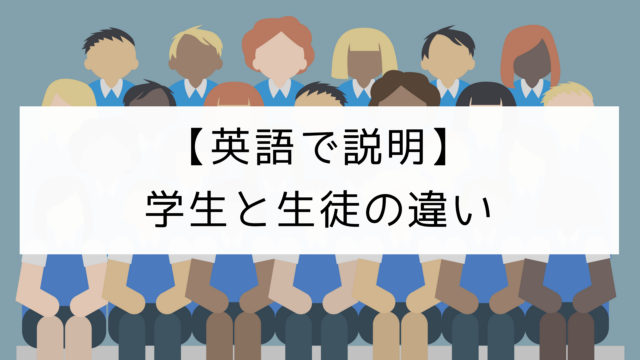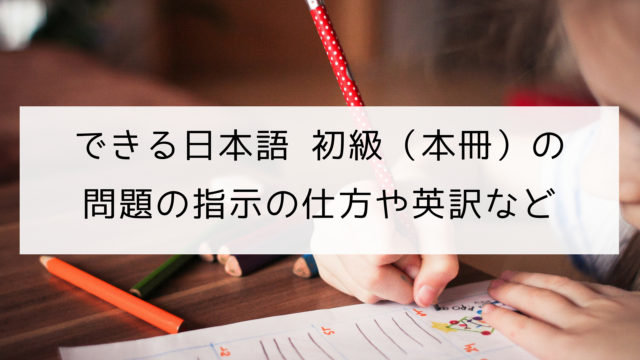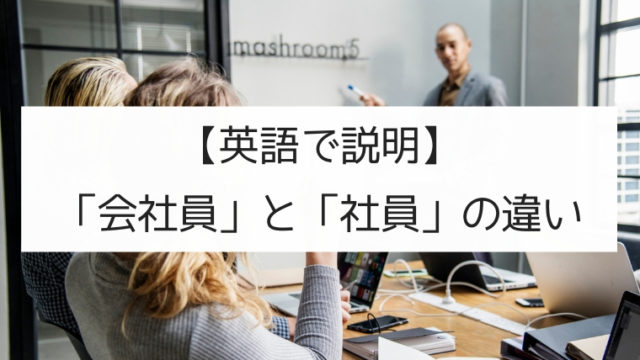このページでは「みんなの日本語 初級1」に登場する文型とその文型の英語解説のまとめページになります。
記事は作成中なので順次更新して行きます。
英語での説明が必要な場合や、ハンドアウトを作る場合などにお役立てください。
みんなの日本語 初級1
第1課
| 文型 |
英語で補足 |
| 〜は〜です。 |
The particle “は” is topic marker, So before “は” is the topic of the sentence. “です” is “is/am/are” in English. This is used with noun or adjective and works as predicate |
| 〜は〜じゃありません。 |
“じゃありません” is the negative form of “です”. |
| 〜は〜の〜です。 |
The particle 「の」 is used to connect two nouns, and when you say what your organization is such as your company or your school, the particle “の” is used. |
| 〜も〜です。 |
The particle “も” is “also” or “too” in English. |
| 〜は〜歳です。 |
“~さい” is used as a counter for age. This is placed after number. |
第2課
| 文型 |
英語で補足 |
| はい、そうです。 |
“XはYです”. If Y is a noun and the answer to this question is “Yes”, the sentence pattern “はい、Yです。” is used. But instead of this pattern, you can always say “はい、そうです。”.
If you use “はい、Yです。”, Y will always change but if you say “はい、そうです。”, even if Y is changes, you always can answer “はい、そうです。” |
| いいえ、違います。 |
If your answer is “No”, the sentence pattern “いいえ、Yじゃありません。” is used. But instead of this pattern you can always say “いいえ、違います。”.
Same as “はい、そうです。”, if you use this sentence pattern, even if Y is changed, you can always answer “いいえ、違います。” |
| 〜の〜です。<内容> |
The particle “の” is used to connect two nouns. When you explain what the thing is about, the particle “の” is used. |
| 何の〜ですか。 |
When you ask what the thing is about, the interrogative “なん” is used. |
| 〜の〜です。<所有> |
When you explain who the thing belongs to, the particle “の” is used. |
| 誰の〜ですか。 |
When you ask who the thing belongs to, the interrogative “だれの” is used. |
| この/その/あの |
If you want to say slightly specific more than “これ/それ/あれ”, you can use ”この/その/あの” with a noun. |
第3課
| 文型 |
英語で補足 |
| ここは〜です。 |
This sentence pattern is used to explain what the place is |
| 〜はここです。 |
This sentence pattern is used to explain the location of places. |
| こちら / そちら / あちら |
“こちら”, “そちら” and “あちら” are more polite than “ここ”, “そこ” and “あそこ” |
| 〜円 |
“円” is a counter for price. |
第4課
| 文型 |
英語で補足 |
| (時間)に〜ます。 |
The particle “に” indicates “time of action”. |
| 〜から〜まで〜ます。 |
The particle “から” indicates a starting time or place.
The particle “まで” indicates a finishing time or place. |
| 〜から〜までです。 |
To mention the starting or finishing time, date of a noun such as “business hours”, “lunch break”, “summer vacation” etc, “〜から”, “〜まで” or “〜から〜まで” can be used with “です”. |
| 助詞「と」 |
The particle “と” is “and” in English. This is used to connect two nouns. |
| 終助詞「ね」 |
The particle “ね” is used to seek the listener’s confirmation or agreement. This is attached to the end of a sentence. |
第5課
| 文型 |
英語で補足 |
| (場所)へ〜ます。 |
The particle “へ” indicates “direction of movement”. |
| (乗り物)で〜ます。 |
The particle “で” indicates “means” or “method”. |
| (人)と〜ます。 |
The particle “と” is with in English. |
| 終助詞「よ」 |
The particle “よ” is used to emphasize the Information which the listener doesn’t’ know. |
第6課
| 文型 |
英語で補足 |
| 〜を〜ます |
The particle “を” indicates “the direct object of a transitive verb”. |
| 何をしますか |
When you ask someone what that person will do, “何をしますか” is used. |
| (場所)で〜ます。 |
The particle “で” indicates “the place of action”. |
| 〜ませんか |
This sentence pattern is used to invite someone to do something. |
| 〜ましょう |
“ましょう” is “let’s” in English. This sentence pattern is used to suggest a plan of action. It is also used to respond positively to an in invitation. |
| もうVました |
もう means “already”, When you use “もう”, Verb is always in the past form. In answering the question “もうVましたか” , if the answer is “yes”, “はい、もうVました” is used. But if the answer is “No”, “いいえ、まだです” is used. Be careful, you can’t say “いいえ, Vませんでした”. |
第7課
| 文型 |
英語で補足 |
| (手段・道具)で〜ます。 |
The particle “で”indicates the method or means. |
| (word / sentence)は〜語で何ですか。 |
This sentence pattern is used when you ask how to say a word or sentence in another language. |
| (人)に〜ます |
To indicate the direction of action such as “あげます(give)”、”教えます(teach)”, the particle “に” is used. If verbs that express the act of receiving such as “もらいます(receive)”, “ならいます(learn)”, the particle “から” is also used. |
第8課
| 文型 |
英語で補足 |
| い形容詞 / な形容詞 |
There are two types of adjectives in Japanese. One type is called “いadjective” and the other type is “なadjective”. “ いadjective” has the final letter “い”. “な adjective” doesn’t end with “い” But there are exceptions, 「ゆうめい」 and 「きれい」has the final letter 「い」 but these are なadjective. |
| とても |
“とても” is “very” in English. This is used to express of degree. |
| あまり〜ない |
“あまり” is “not very” in English. When this is used, the adjective is always used with a negative form. |
| 〜はどうですか |
This question is used to ask about the listener’s impression or opinion. |
| どんな〜ですか |
どんな is “what “kind of”, “what sort of” in English. This sentence pattern is used when you ask about the state or the character of a person, thing, etc, |
第9課
| 文型 |
英語で補足 |
| あります / います / 好きです / 嫌いです/ 上手です / 下手です |
“あります”、”います”、”好きです”、”嫌いです”、”上手です”, “下手です” are marked with the particle “が” |
| どうして |
“どうして” is “why” in English. This is used to ask the reason for something. |
第10課
| 文型 |
英語で補足 |
| あります/います の違い |
“あります” is used for things that can move by itself. “います” is used for people and animals that can move by itself. That’s why “あります” is used for “plants”. |
| 〜に〜があります。 |
「〜に〜があります/います」is used to indicate the existence of things or persons. |
| 〜は〜にあります。 |
「〜は〜にあります」is used when you describe the location of things or persons. |
| 〜や |
“や” is used to connect two nouns, and this is used when you want to say some examples and not everything. |
第11課
| 文型 |
英語で補足 |
| 〜まい |
“まい” is a counter for flat things such as “paper”. “T-shirts.” |
| 〜だい |
“だい” is a counter for machines or some vehicles. |
| 〜にん |
“にん” is a counter for people. |
| 〜だけ |
“だけ” is “only” in English. It’s placed after quantifiers or nouns. |
第12課
| 文型 |
英語で補足 |
| 〜と〜とどちらが〜ですか |
This sentence pattern is used when you ask for another person’s opinion on two things that are in comparison. |
| 〜で〜がいちばん〜です |
In comparison among three or more things, the degree qualifier “いちばん” is used. |
第13課
| 文型 |
英語で補足 |
| 〜が欲しいです |
〜ほしいです is “want” in English. This belongs to “い adjective” and the object of desire is followed by the particle “が”. |
| 〜たいです |
〜たいです is “want to (verb)” in English. This sentence pattern is used to express the speaker’s desire to do something. |
| 〜に行きます |
The particle “に” indicates the purpose of the action |
第14課
| 文型 |
英語で補足 |
| 〜ましょうか。 |
This sentence pattern is used when the speaker is offering to do something for the listener. |
| 〜ています |
This sentence pattern expresses the action in progress. |
| すみませんが、〜 |
The “が” in expression such as “すみませんが” is not being used as ‘’BUT’’, but as like an introduction for the next phrase. |
第15課
| 文型 |
英語で補足 |
| 〜てもいいですか。 |
This sentence pattern is used to ask permission to do something. |
| 〜ています(結果) |
This sentence pattern is also used in describing a certain continuing state which resulted from a certain action in the past. |
| 〜ています(習慣) |
This is also used to show a habitual action (the same action repeated over a long
period), occupation or personal status. |
| 〜てはいけません。 |
This sentence pattern is used to express prohibition. |
第16課
| 文型 |
英語で補足 |
| V1てV2 |
When describing two or more actions, this pattern is used. To combine two verbs, て form is used. |
| どうやって |
“どうやって” is “how” in English. This is used to ask the way how to do it. |
第17課
| 文型 |
英語で補足 |
| 〜ないでください |
This sentence pattern is used to ask someone not to do something. |
| 〜なければなりません |
This sentence pattern is used when the speaker says that it is necessary to do something or it must be done. |
| 〜なくてもいいです |
This sentence pattern is used to describe what you don’t need to do. |
| 〜までに |
“までに” indicates “time limit”. This is used when an action must be done or the event will end by that time. |
第18課
| 文型 |
英語で補足 |
| なかなか |
This sentence pattern is used with a negative and this means that something is not easily done. |
| ぜひ |
ぜひ means “by all means”. This is used to emphasize the speaker’s hope. |
第19課
| 文型 |
英語で補足 |
| 〜たことがあります |
This sentence pattern is used when describing a particular experience you had before. |
| 〜たり〜たり |
This sentence pattern is used to tell someone that you did two or more actions. |
| 〜になります |
“なります” is “become” in English. This indicates a change of state. |
第21課
| 文型 |
英語で補足 |
| 〜と思います |
This is used to express the speaker’s conjecture or used when saying an opinion. |
| 〜でしょう? |
“でしょう?” is used to seek the listener’s confirmation or agreement. |
第23課
| 文型 |
英語で補足 |
| 〜と |
This sentence pattern is used if a certain action or phenomenon happens, then another action or phenomena will inevitably happen. |
おすすめ書籍
¥2,200
(2025/10/30 09:37:17時点 Amazon調べ-詳細)





